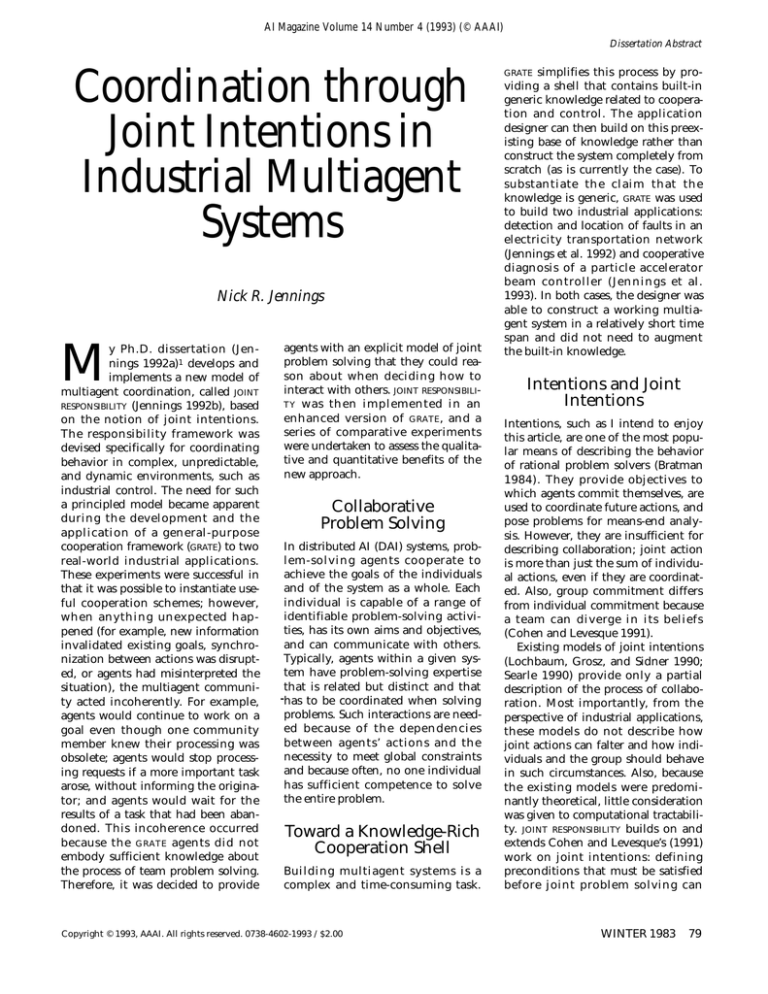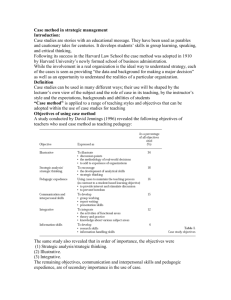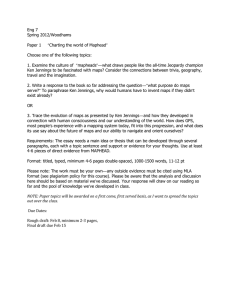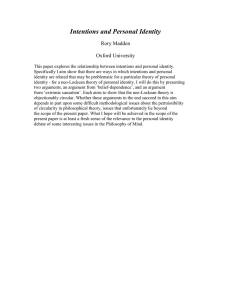
AI Magazine Volume 14 Number 4 (1993) (© AAAI)
Dissertation Abstract
Coordination through
Joint Intentions in
Industrial Multiagent
Systems
Nick R. Jennings
M
y Ph.D. dissertation (Jennings 1992a)1 develops and
implements a new model of
multiagent coordination, called JOINT
RESPONSIBILITY (Jennings 1992b), based
on the notion of joint intentions.
The responsibility framework was
devised specifically for coordinating
behavior in complex, unpredictable,
and dynamic environments, such as
industrial control. The need for such
a principled model became apparent
during the development and the
application of a general-purpose
cooperation framework (GRATE) to two
real-world industrial applications.
These experiments were successful in
that it was possible to instantiate useful cooperation schemes; however,
when anything unexpected happened (for example, new information
invalidated existing goals, synchronization between actions was disrupted, or agents had misinterpreted the
situation), the multiagent community acted incoherently. For example,
agents would continue to work on a
goal even though one community
member knew their processing was
obsolete; agents would stop processing requests if a more important task
arose, without informing the originator; and agents would wait for the
results of a task that had been abandoned. This incoherence occurred
because the GRATE agents did not
embody sufficient knowledge about
the process of team problem solving.
Therefore, it was decided to provide
agents with an explicit model of joint
problem solving that they could reason about when deciding how to
interact with others. JOINT RESPONSIBILIT Y was then implemented in an
enhanced version of GRATE , and a
series of comparative experiments
were undertaken to assess the qualitative and quantitative benefits of the
new approach.
Collaborative
Problem Solving
In distributed AI (DAI) systems, problem-solving agents cooperate to
achieve the goals of the individuals
and of the system as a whole. Each
individual is capable of a range of
identifiable problem-solving activities, has its own aims and objectives,
and can communicate with others.
Typically, agents within a given system have problem-solving expertise
that is related but distinct and that
has to be coordinated when solving
problems. Such interactions are needed because of the dependencies
between agents’ actions and the
necessity to meet global constraints
and because often, no one individual
has sufficient competence to solve
the entire problem.
Toward a Knowledge-Rich
Cooperation Shell
Building multiagent systems is a
complex and time-consuming task.
Copyright © 1993, AAAI. All rights reserved. 0738-4602-1993 / $2.00
GRATE simplifies this process by providing a shell that contains built-in
generic knowledge related to cooperation and control. The application
designer can then build on this preexisting base of knowledge rather than
construct the system completely from
scratch (as is currently the case). To
substantiate the claim that the
knowledge is generic, GRATE was used
to build two industrial applications:
detection and location of faults in an
electricity transportation network
(Jennings et al. 1992) and cooperative
diagnosis of a particle accelerator
beam controller (Jennings et al.
1993). In both cases, the designer was
able to construct a working multiagent system in a relatively short time
span and did not need to augment
the built-in knowledge.
Intentions and Joint
Intentions
Intentions, such as I intend to enjoy
this article, are one of the most popular means of describing the behavior
of rational problem solvers (Bratman
1984). They provide objectives to
which agents commit themselves, are
used to coordinate future actions, and
pose problems for means-end analysis. However, they are insufficient for
describing collaboration; joint action
is more than just the sum of individual actions, even if they are coordinated. Also, group commitment differs
from individual commitment because
a team can diverge in its beliefs
(Cohen and Levesque 1991).
Existing models of joint intentions
(Lochbaum, Grosz, and Sidner 1990;
Searle 1990) provide only a partial
description of the process of collaboration. Most importantly, from the
perspective of industrial applications,
these models do not describe how
joint actions can falter and how individuals and the group should behave
in such circumstances. Also, because
the existing models were predominantly theoretical, little consideration
was given to computational tractability. JOINT RESPONSIBILITY builds on and
extends Cohen and Levesque’s (1991)
work on joint intentions: defining
preconditions that must be satisfied
before joint problem solving can
WINTER 1983
79
Dissertation Abstract
commence and extending the notion
of joint commitment to plan states.
Responsibility specifies that each individual within a team should remain
committed to achieving the common
objective by the agreed solution until
one of the following statements
becomes true: The objective has been
met, the objective will never be met,
the motivation for the action is no
longer present, the desired outcome
of a plan step is already available, following the agreed action sequence
does not achieve the desired outcome,
one of the specified actions cannot be
carried out, or one of the agreed
actions has not been carried out.
While in this state, the agent will
honor its commitments and carry out
its agreed actions. However, if an
agent is no longer committed to the
joint action or the common solution,
it cannot simply abandon its processing because its accomplices might not
have been able to detect the problem.
For this reason, the responsibility
model stipulates that when a team
member is no longer jointly committed to the joint action, it must ensure
that all its acquaintances are
informed of this change of state.
Thus, the whole team can reassess the
viability of the joint action and, in
particular, the actions involving the
agent that is no longer committed.
A rule-based interpretation of JOINT
RESPONSIBILITY was then used to build
agents that had an explicit and principled model of collaboration to guide
their individual actions and their
social interactions.
Experimental Evaluation
A series of comparative experiments
were undertaken to assess the performance characteristics of the responsibility model (Jennings and Mamdani
1992). Three types of problem-solving
organization were compared: (1) a
responsible community; (2) an implicit group model in which agents had
individual intentions but did not form
explicit collaborating groups; and (3)
groups of problem solvers who set up
joint intentions but, when the joint
action became unsustainable, behaved
selfishly and simply abandoned their
local processing without informing
80
AI MAGAZINE
their fellow team members.
These experiments showed that the
responsible community performed
significantly more coherently than
the other two, this difference being
especially noticeable as the domain
became more dynamic and unpredictable (that is, the chance of jointaction unsustainability increased).
This gain in performance was
achieved with negligible extra processing requirements for the coordination mechanisms.
Conclusions
This work shows, through empirical
evaluation on a real-world problem,
that a suitably formulated model of
joint intentions is a powerful mechanism for coordinating the behavior of
collaborating agents. The model is
especially useful when agents have to
make decisions using partial and
imprecise information and when the
environment itself is evolving and
unpredictable. It also indicates how
theoretical models of coordination
can be used as a basis for implementation-level systems. Two new domains
in which DAI techniques can be
exploited profitably were also highlighted. Finally, as a consequence of
the insights gained in this work, a
proposal for the next generation of
multiagent systems was made. In such
cooperation knowledge-level systems
(Jennings 1992b), individuals maintain and reason about explicit and
deep representations of social interactions rather than have an implicit and
shallow understanding of these processes.
Acknowledgments
This work benefited greatly from the
guidance received from Abe Mamdani, Erick Gaussens, and Thies Wittig. Jose Corera, Inaki Laresgoiti, Juan
Perez, Rob Aarnts, Paul Skarek, Laszlo
Varga, and Joachim Fuchs provided
valuable help by applying GRATE to the
real-world applications. This work has
been supported in part by the ESPRIT
II Project ARCHON (P-2256).
Note
1. Copies of this dissertation (KEAG-TR-9218) can be obtained by writing to the
author at the Department of Electronic
Engineering, Queen Mary and Westfield
College, University of London, Mile End
Road, London E1 4NS, UK. E-mail requests
should be addressed to N.R.Jennings
@qmw.ac.uk. An updated version of the
thesis, entitled “Cooperation in Industrial
Multi-Agent Systems,” will be published by
World Scientific Press in 1994.
References
Bratman, M. E. 1984. Two Faces of Intention. Philosophical Review 93:375–405.
Cohen, P. R., and Levesque, H. J. 1991.
Teamwork. Nous 25(4): 487–512.
Jennings, N. R. 1992a. Joint Intentions as a
Model of Multi-Agent Cooperation. Ph.D.
diss., Dept. of Electronic Engineering,
Queen Mary and Westfield College, University of London.
Jennings, N. R. 1992b. Toward a Cooperation Knowledge Level for Collaborative
Problem Solving. In Proceedings of the
Tenth European Conference on Artificial
Intelligence, 224–228. New York: John
Wiley and Sons.
Jennings, N. R., and Mamdani, E. H. 1992.
Using Joint Responsibility to Coordinate
Collaborative Problem Solving in Dynamic
Environments. In Proceedings of the Tenth
National Conference on Artificial Intelligence, 269–275. Menlo Park, Calif.: American Association for Artificial Intelligence.
Jennings, N. R.; Mamdani, E. H.; Laresgoiti, I.; Perez, J.; and Corera, J. 1992.
GRATE: A General Framework for Cooperative Problem Solving. Journal of Intelligent
Systems Engineering 1(2): 102–114.
Jennings, N. R.; Varga, L. Z.; Aarnts, R. P.;
Fuchs, J.; and Skarek, P. 1993. Transforming Standalone Expert Systems into a
Community of Cooperating Agents. International Journal of Engineering Applications
of Artificial Intelligence 6(4): 317–331.
Lochbaum, K. E.; Grosz, B. J.; and Sidner,
C. L. 1990. Models of Plans to Support
Communication. In Proceedings of the
Eighth National Conference on Artificial
Intelligence, 485–490. Menlo Park, Calif.:
AAAI.
Searle, J. 1990. Collective Intentions and
Actions. In Intentions in Communication, eds.
P. R. Cohen, J. Morgan, and M. E. Pollack,
401–416. Cambridge, Mass.: MIT Press.
Nick R. Jennings is a lecturer in the
Department of Electronic Engineering at
Queen Mary and Westfield College (University of London). He obtained his Ph.D.
in AI from Queen Mary and Westfield College in 1992. His current research interests
include coordination in multiagent systems, conflict resolution, joint intentions,
and metalevel control architectures.




